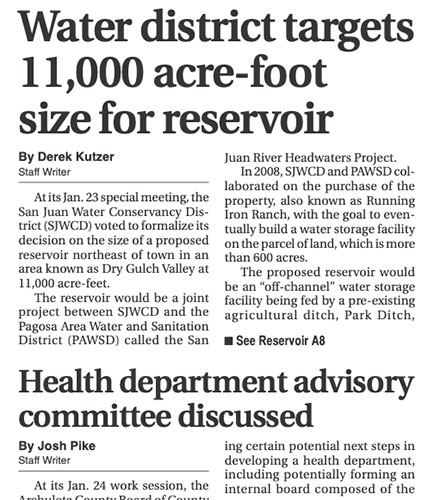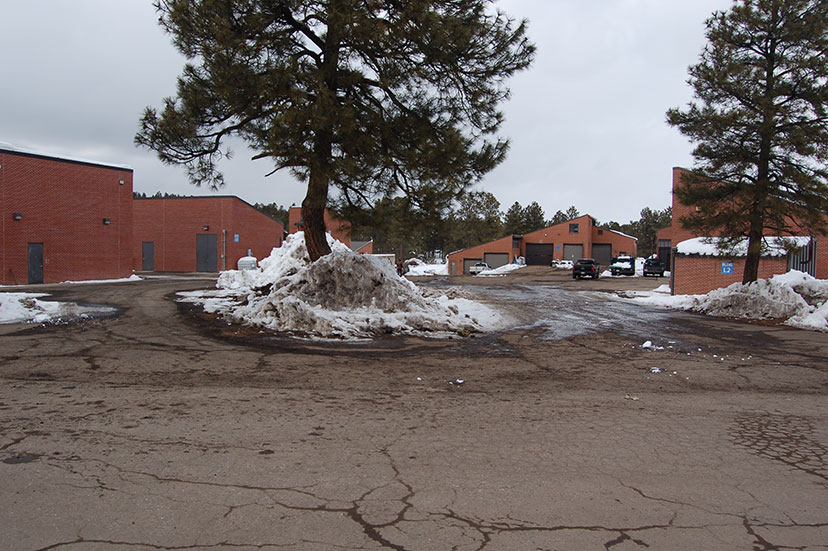PHOTO: Pagosa Area Water and Sanitation Wastewater Treatment Plant on Lyn Avenue. Winter, 2023.
At the beginning of yesterday’s Pagosa Area Water and Sanitation (PAWSD) board meeting, Board President Jim Smith opened the floor for public comment.
One person from the audience availed himself of the opportunity: Al Pfister, the president of the San Juan Water Conservancy District (SJWCD). A simple, straightforward comment.
“Just reiterating the getting together… the San Juan Water Conservancy District and PAWSD, getting together.”
President Smith: “Yes, we’ve got to do that. We’ll probably do that at our next meeting.”
The volunteer boards of our community’s two water districts have been expressing an intention of getting together for a few months now… to possibly hammer out some disagreements? As mentioned earlier in this editorial series, PAWSD and SJWCD jointly purchased a 660-acre ranch in 2008, with the stated intention of building a fairly large water storage reservoir called the Dry Gulch Reservoir.
The PAWSD customers were saddled with paying for the $10 million purchase, and the plan, in 2008, was to have PAWSD customers also pay for a $357 million reservoir project.
In 2008, the Conservancy District had a budget of about $60,000, so no one expected them to pay for a reservoir. The PAWSD budget is currently about $38 million per year.
We could, if we were so inclined, look at the relationship of these two water districts as the Lion and the Mouse. If the two district were going to meet jointly, the unspoken assumption was that the meeting would take place at the convenience of the PAWSD board, at the PAWSD offices.
PAWSD District Manager Justin Ramsey addressed President Pfister: “Our next meeting is February 9. Would that work for you guys?”
President Pfister didn’t exactly answer the question: “We just scheduled our next meeting for February 20. That’s a holiday, but… um… that’s when our people were available…”
District Manager Ramsey: “Would you rather schedule it for our March meeting?”
President Pfister: “No, I’d rather… see if we can have at least a quorum on February 9, and go from there, because we…”
President Smith: “Well, our board, really… we’ve got to make some decisions about what we want to decide on. You know, I read this in the [Pagosa Springs SUN] newspaper. It says, ‘Water district targets 11,000 acre-foot size for reservoir’. It says ‘Water district’.
“Makes it sound like the PAWSD board did that, and we didn’t decide that. It was the Conservancy District that decided that. So that was not a very good headline…”

District Manager Ramsey noted that he’d received a number of phone calls, following the appearance of the January 26 article.
President Smith addressed his board. “I think we need to discuss that at our next meeting, on February 9; what’s our opinion of that. So when we meet with the Conservancy board, we’ll have it all sized up, how we want to address it. Do we all agree?” He got nods of agreement from his board.
Disclosure: I currently serve on the PAWSD Board of Directors, but this editorial series reflects only my personal opinions, and not necessarily the opinions of the PAWSD Board as a whole.
I can’t speak for the rest of the PAWSD board, but it’s my opinion that the SJWCD board’s endorsement of an 11,000 acre-foot reservoir project was based on faulty information, and a faulty understanding of how our community wants to spend its limited fiscal resources.
Water has become an ever-more-expensive resource, as evidenced by the rate increases approved by the PAWSD board last night.
Ditto, wastewater.
As I write this installment, I’m thinking about wastewater, in particular. A significant portion of last night’s meeting dealt with upgrades to the PAWSD wastewater treatment facility. We heard a lengthy explanation from Mark Maxwell of Tetra Tech, giving the reasons why PAWSD might be spending $50 million in customer and taxpayer money over the next 10 years, to keep the Vista Wastewater Treatment Plant compliant with Colorado water policies.
I’m also thinking about technology.
100 years ago, a news publisher like myself — on a mission to help inform the citizens living in a small town like Pagosa Springs — would have needed an industrial printing operation involving large rolls of paper, barrels of ink, a good-size printing press, a linotype machine, and a team of workers: reporters, editor, ad salesperson, pressmen, a linotype operator and a crew of newspaper boys doing the deliveries.
The system worked well enough, although the Linotype machine was probably phased out in the 1980s, and the Post Office took over the delivery duties. But in spite of some impressive technological changes in how a newspaper is assembled… when you pick up a copy of the Pagosa Springs SUN on Thursday, the product looks surprisingly similar to the newspapers from 1923.
Technology doesn’t always mean “instantaneous”, however. In the case of the SUN, it takes a full week to put together each issue.
An online community magazine like the Pagosa Daily Post, meanwhile, has little in common with a print newspaper, in terms of its production and distribution. It requires no paper, no ink, no printing press; beyond the research, the attendance at public meetings, and the writing of the articles, the production and distribution of each issues takes about an hour. Maybe two hours, tops.
Apparently, the Pagosa Springs SUN still brings in enough advertising revenue to maintain a staff of about eight people. I believe the SUN has four paid reporters at the moment? Which is pretty impressive for a small-town newspaper that publishes once a week. The Daily Post, by comparison, has a staff of one.
Two rather different approaches to news delivery. Two different uses of technology.
I appreciate the amount of work involved in attending a (sometimes lengthy) government meeting and then composing a story about it, on deadline. The SUN story by Derek Kutzer about the San Juan Water Conservancy District endorsement of an unpopular 11,000 acre-foot reservoir, for example. The story that PAWSD President Smith mentioned last night.
The subject of technology is on my mind this morning because certain types of technology have greatly changed our lives in the 100 years since 1923. Automobiles, for one obvious example. Computers and smart phones, for another. Some systems, however, have not changed much.
How about toilets? That’s a technology that hasn’t changed much since the middle of the 20th century.
I’m choosing “the middle of the 20th century” because, here in Pagosa Springs, relatively few homes had flush toilets until about 1950. If you went all the way back to 1923, you’d find a different technology in use.
The outhouse. A low-tech solution.

I’m going to dig a little deeper, tomorrow, into that proposal from Mark Maxwell… that our community will be asked to spend $50 million on wastewater treatment upgrades, over the next 10 years.
And maybe, a little deeper into the outhouse idea.

